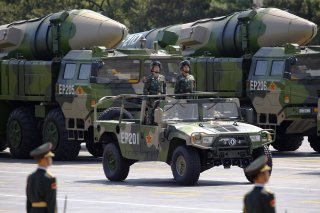China's New Carrier-Killer Missile Could Mean Big Trouble for the Navy
The DF-21D--now 30% more powerful
Media reports suggest that a new variant of China’s mighty DF-21D missile has just gone through pre-deployment tests by a specialist brigade of the People’s Liberation Army’s Rocket Force, and that it has ramped-up assault capabilities that could put an aircraft-carrier strike group out of action.
State broadcaster China Central Television and Sina Military reported that the new missile was “30%” more powerful than the previous-generation DF-21D, but no details of its specifications or the parameters of the tests were provided.
It is believed that the series’ launch vehicle has received a big boost to its ability to travel off-road, as compared with the previous model that required support vehicles and would need to park on a huge solid-surface area prior to a launch.
It is not clear if the missile itself has been improved in terms of range or speed.
Recommended: America Has Military Options for North Korea (but They're All Bad)
Recommended: 1,700 Planes Ready for War: Everything You Need To Know About China's Air Force
Recommended: Stealth vs. North Korea’s Air Defenses: Who Wins?
When the missile family first entered service, it was said to be the world’s first hypersonic, satellite-guided anti-ship ballistic missile capable of targeting a moving aircraft carrier, with a maximum range exceeding 1,450 kilometers on the strength of its maneuverable re-entry vehicles, a terminal guidance system and over-the-horizon radar.
It is thought to be able to carry high-explosive and submunition warheads, as well as a nuclear warhead of 300 kilotons.
In a nutshell, the might of the DF-21D family, nicknamed “carrier killer,” means that Washington would have to think twice before sending its carriers into the Taiwan Strait and risking the lives of its crews should Beijing mount an invasion to reclaim the self-ruling island, which it considers a breakaway province.
In the 1995 Taiwan Strait crisis, the Pentagon dispatched the USS Nimitz to pass through the strait in a high-profile co-defense posture after Beijing held drills in the East China Sea in a bid to discourage Taiwanese against electing a pro-independence president. Beijing had to back down amid Washington’s intervention.
With the DF-21D missile, Beijing has erased that ignominy.
A 2009 US Naval Institute report confirmed the formidable threat of the missile, noting that its warhead would be large enough to destroy a carrier in one hit and that in theory there was “currently no defense against it.”
The Pentagon has marshaled ballistic-missile defense destroyers as well as missile interceptors to the Pacific to give carrier groups stationed there sufficient warning to move away from a targeted area whenever the missile is airborne.
The missile has been deployed along China’s coast in such provinces as Fujian, Zhejiang, Guangdong, Jiangsu, Shandong and Liaoning to make sure that warships in the Taiwanese and Japanese navies and even of the US Seventh Fleet are overawed in the event of a military showdown in the Taiwan Strait.

